University Research: Job Satisfaction and Employee Turnover Analysis
VerifiedAdded on 2022/09/07
|11
|2370
|29
Report
AI Summary
This report examines the critical relationship between job satisfaction and employee turnover within the Australian hospitality sector, focusing on five prominent hotels. It begins by establishing the research background, highlighting the costly impact of employee turnover and the importance of monitoring job satisfaction. The report then delves into a comprehensive literature review, exploring theoretical frameworks like Herzberg's two-factor theory, and analyzes the factors influencing employee turnover, such as wages, career growth, work pressure, and training. The research methodology incorporates both primary and secondary data collection methods, including questionnaires, interviews, and a review of journal articles and literature. The study aims to identify the correlation between job satisfaction and employee turnover, providing valuable insights for managers and leaders to reduce turnover rates and improve business operations. The report uses a Gantt chart to illustrate the research timeline and concludes with a list of cited references.
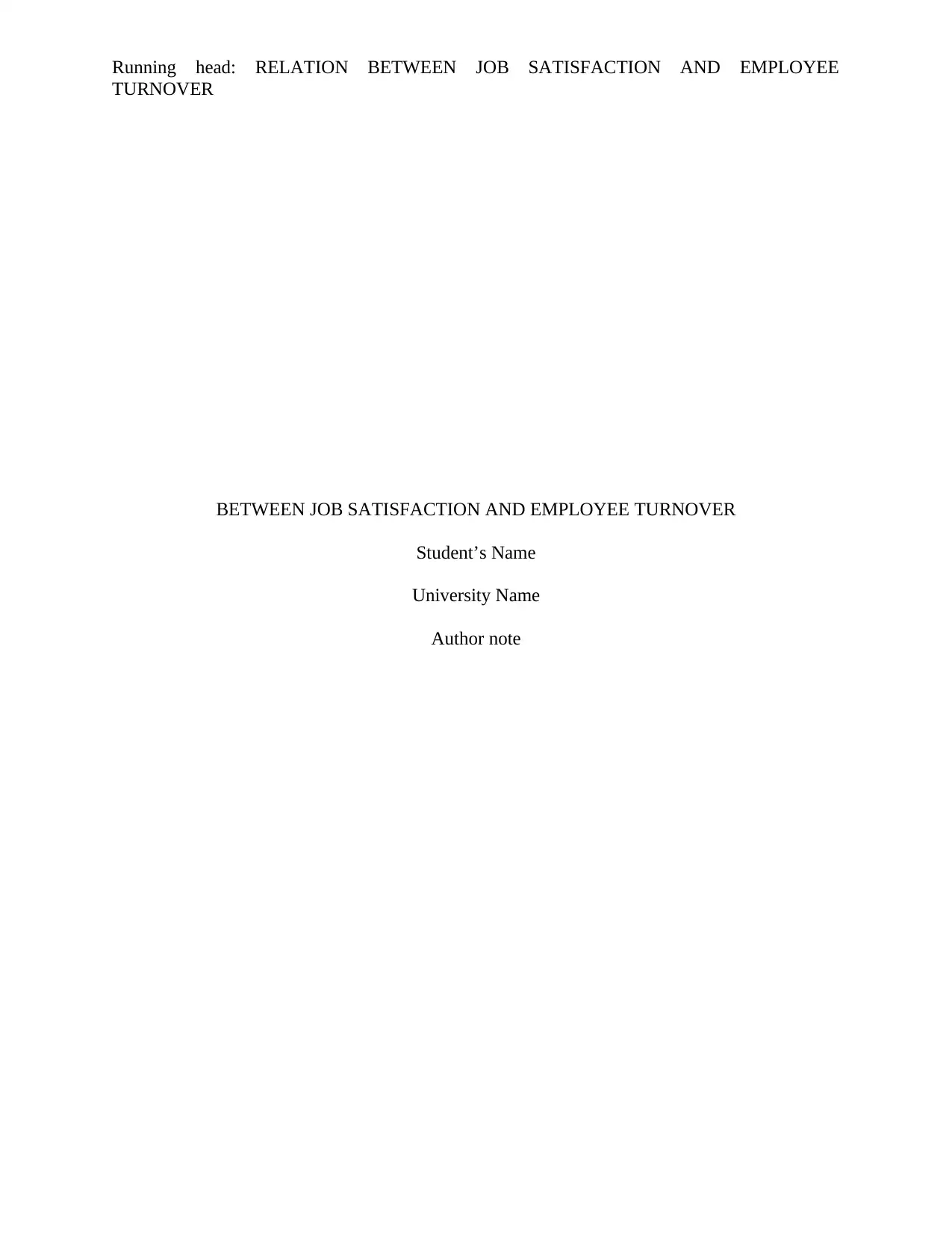
Running head: RELATION BETWEEN JOB SATISFACTION AND EMPLOYEE
TURNOVER
BETWEEN JOB SATISFACTION AND EMPLOYEE TURNOVER
Student’s Name
University Name
Author note
TURNOVER
BETWEEN JOB SATISFACTION AND EMPLOYEE TURNOVER
Student’s Name
University Name
Author note
Paraphrase This Document
Need a fresh take? Get an instant paraphrase of this document with our AI Paraphraser
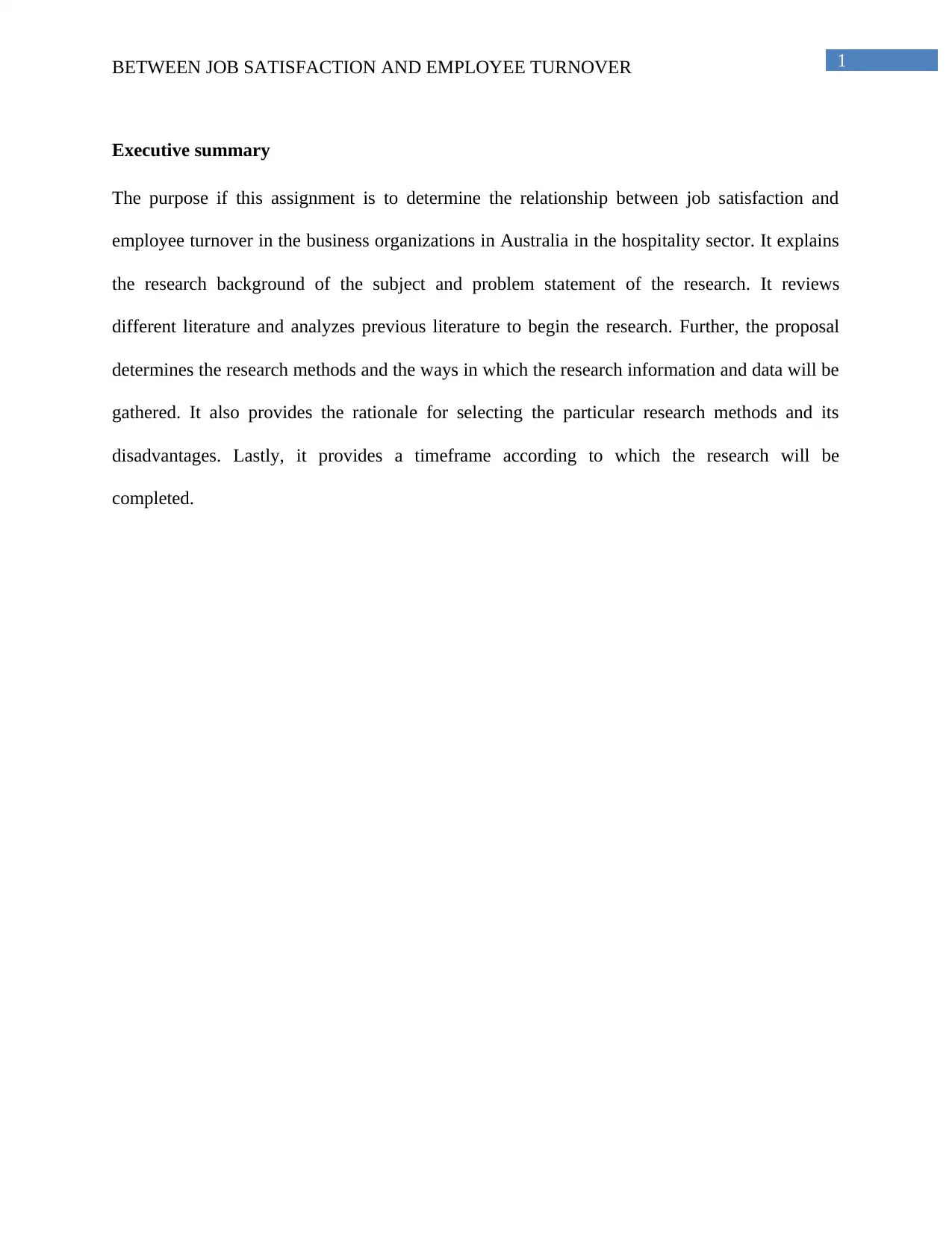
1BETWEEN JOB SATISFACTION AND EMPLOYEE TURNOVER
Executive summary
The purpose if this assignment is to determine the relationship between job satisfaction and
employee turnover in the business organizations in Australia in the hospitality sector. It explains
the research background of the subject and problem statement of the research. It reviews
different literature and analyzes previous literature to begin the research. Further, the proposal
determines the research methods and the ways in which the research information and data will be
gathered. It also provides the rationale for selecting the particular research methods and its
disadvantages. Lastly, it provides a timeframe according to which the research will be
completed.
Executive summary
The purpose if this assignment is to determine the relationship between job satisfaction and
employee turnover in the business organizations in Australia in the hospitality sector. It explains
the research background of the subject and problem statement of the research. It reviews
different literature and analyzes previous literature to begin the research. Further, the proposal
determines the research methods and the ways in which the research information and data will be
gathered. It also provides the rationale for selecting the particular research methods and its
disadvantages. Lastly, it provides a timeframe according to which the research will be
completed.
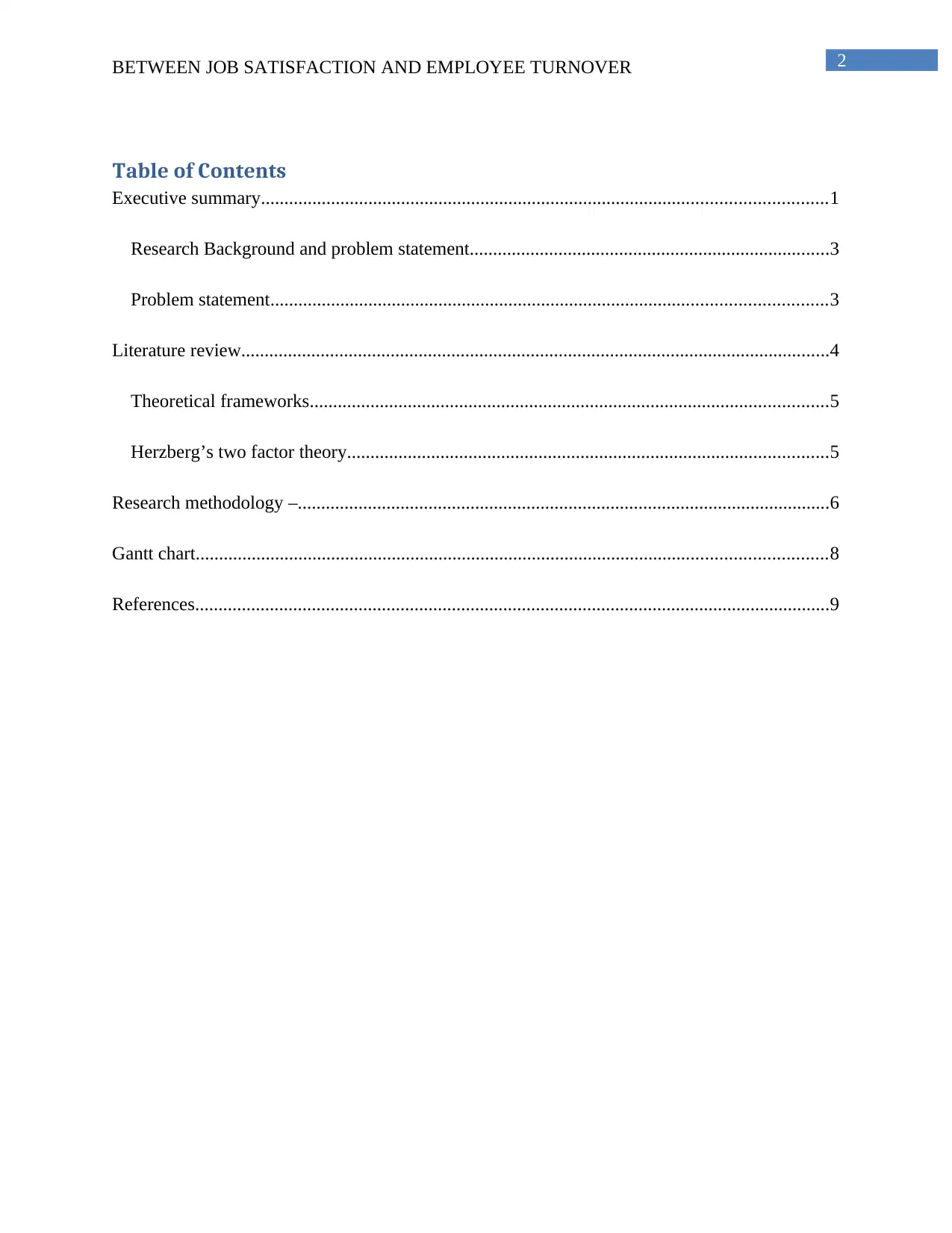
2BETWEEN JOB SATISFACTION AND EMPLOYEE TURNOVER
Table of Contents
Executive summary.........................................................................................................................1
Research Background and problem statement.............................................................................3
Problem statement.......................................................................................................................3
Literature review..............................................................................................................................4
Theoretical frameworks...............................................................................................................5
Herzberg’s two factor theory.......................................................................................................5
Research methodology –..................................................................................................................6
Gantt chart.......................................................................................................................................8
References........................................................................................................................................9
Table of Contents
Executive summary.........................................................................................................................1
Research Background and problem statement.............................................................................3
Problem statement.......................................................................................................................3
Literature review..............................................................................................................................4
Theoretical frameworks...............................................................................................................5
Herzberg’s two factor theory.......................................................................................................5
Research methodology –..................................................................................................................6
Gantt chart.......................................................................................................................................8
References........................................................................................................................................9
⊘ This is a preview!⊘
Do you want full access?
Subscribe today to unlock all pages.

Trusted by 1+ million students worldwide
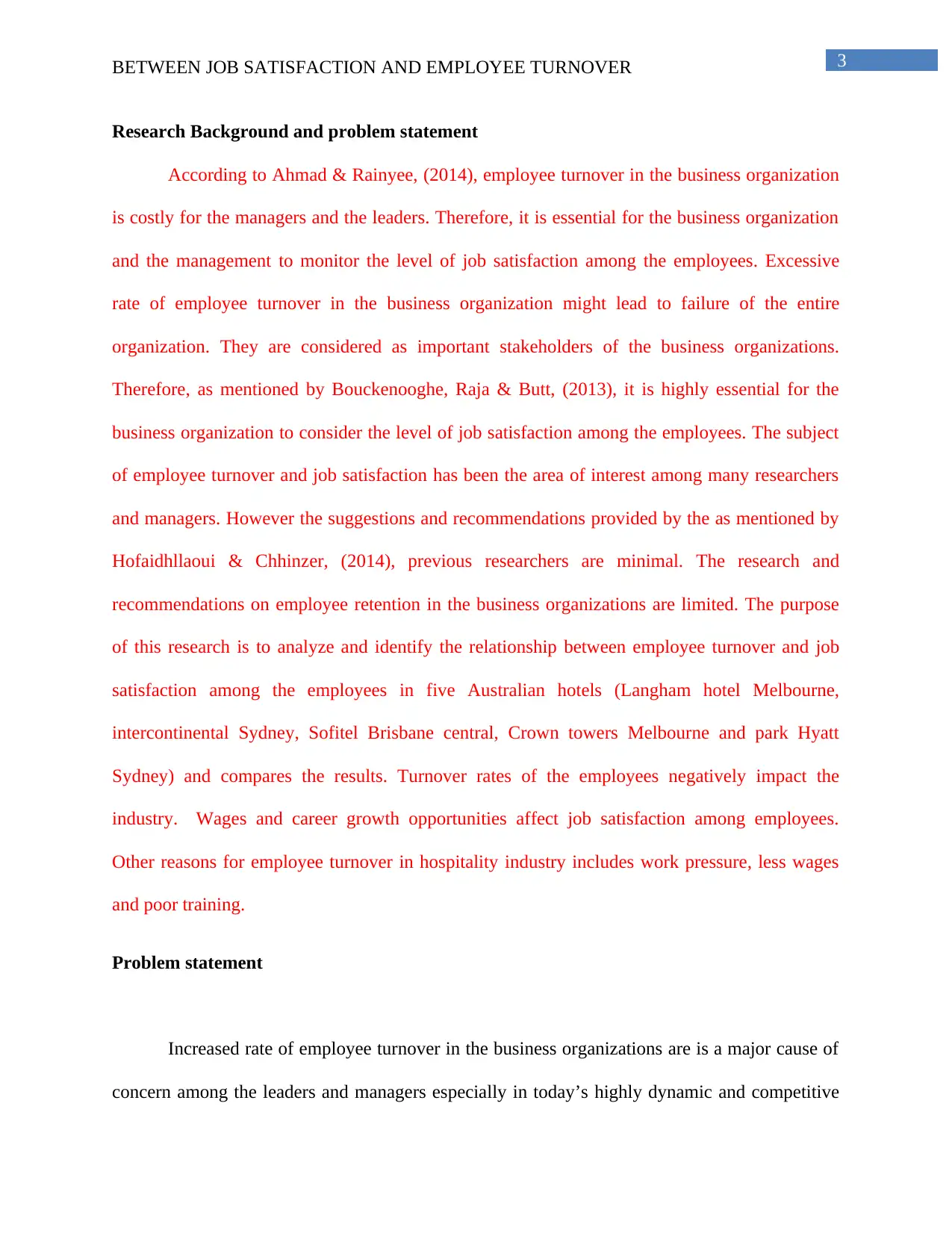
3BETWEEN JOB SATISFACTION AND EMPLOYEE TURNOVER
Research Background and problem statement
According to Ahmad & Rainyee, (2014), employee turnover in the business organization
is costly for the managers and the leaders. Therefore, it is essential for the business organization
and the management to monitor the level of job satisfaction among the employees. Excessive
rate of employee turnover in the business organization might lead to failure of the entire
organization. They are considered as important stakeholders of the business organizations.
Therefore, as mentioned by Bouckenooghe, Raja & Butt, (2013), it is highly essential for the
business organization to consider the level of job satisfaction among the employees. The subject
of employee turnover and job satisfaction has been the area of interest among many researchers
and managers. However the suggestions and recommendations provided by the as mentioned by
Hofaidhllaoui & Chhinzer, (2014), previous researchers are minimal. The research and
recommendations on employee retention in the business organizations are limited. The purpose
of this research is to analyze and identify the relationship between employee turnover and job
satisfaction among the employees in five Australian hotels (Langham hotel Melbourne,
intercontinental Sydney, Sofitel Brisbane central, Crown towers Melbourne and park Hyatt
Sydney) and compares the results. Turnover rates of the employees negatively impact the
industry. Wages and career growth opportunities affect job satisfaction among employees.
Other reasons for employee turnover in hospitality industry includes work pressure, less wages
and poor training.
Problem statement
Increased rate of employee turnover in the business organizations are is a major cause of
concern among the leaders and managers especially in today’s highly dynamic and competitive
Research Background and problem statement
According to Ahmad & Rainyee, (2014), employee turnover in the business organization
is costly for the managers and the leaders. Therefore, it is essential for the business organization
and the management to monitor the level of job satisfaction among the employees. Excessive
rate of employee turnover in the business organization might lead to failure of the entire
organization. They are considered as important stakeholders of the business organizations.
Therefore, as mentioned by Bouckenooghe, Raja & Butt, (2013), it is highly essential for the
business organization to consider the level of job satisfaction among the employees. The subject
of employee turnover and job satisfaction has been the area of interest among many researchers
and managers. However the suggestions and recommendations provided by the as mentioned by
Hofaidhllaoui & Chhinzer, (2014), previous researchers are minimal. The research and
recommendations on employee retention in the business organizations are limited. The purpose
of this research is to analyze and identify the relationship between employee turnover and job
satisfaction among the employees in five Australian hotels (Langham hotel Melbourne,
intercontinental Sydney, Sofitel Brisbane central, Crown towers Melbourne and park Hyatt
Sydney) and compares the results. Turnover rates of the employees negatively impact the
industry. Wages and career growth opportunities affect job satisfaction among employees.
Other reasons for employee turnover in hospitality industry includes work pressure, less wages
and poor training.
Problem statement
Increased rate of employee turnover in the business organizations are is a major cause of
concern among the leaders and managers especially in today’s highly dynamic and competitive
Paraphrase This Document
Need a fresh take? Get an instant paraphrase of this document with our AI Paraphraser
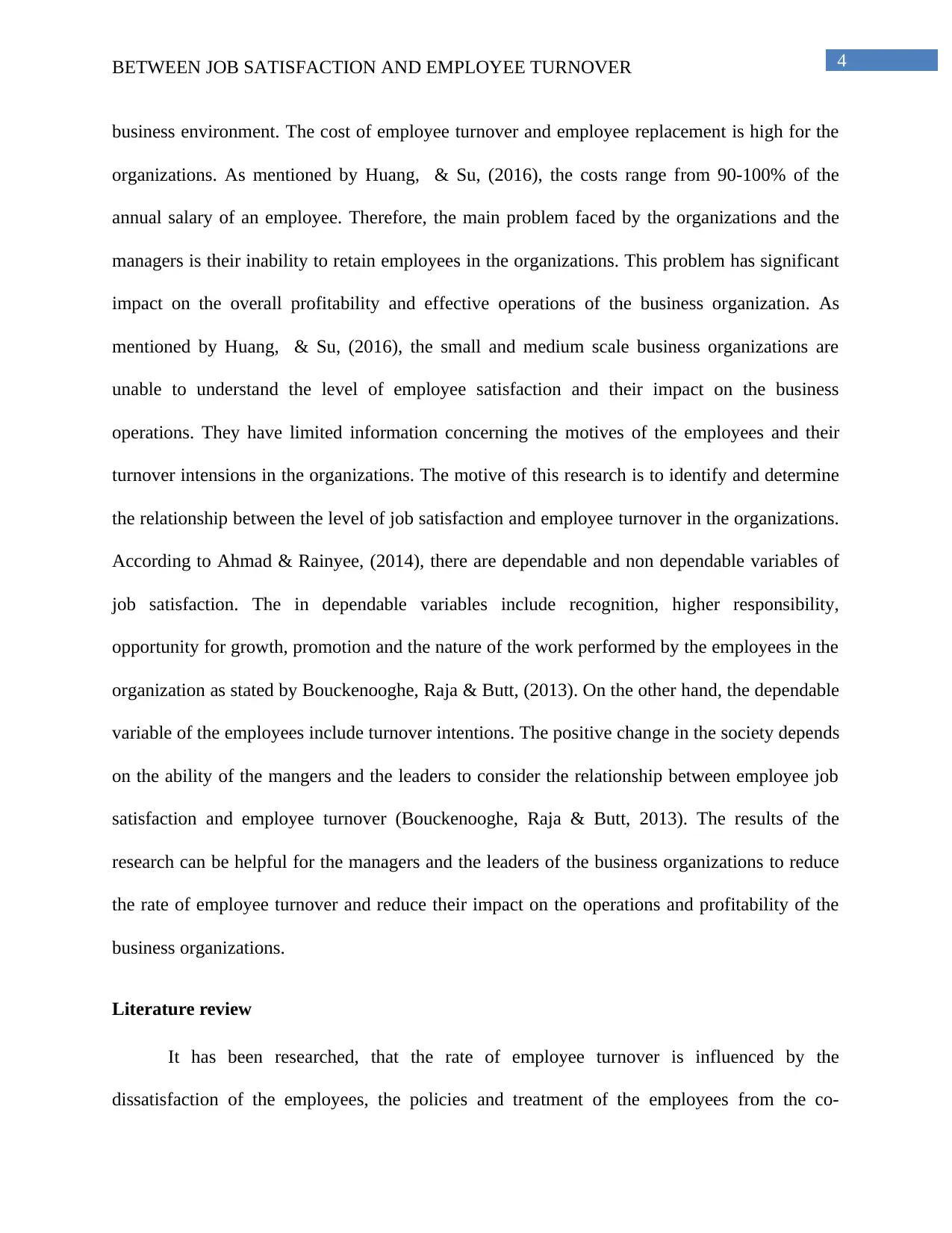
4BETWEEN JOB SATISFACTION AND EMPLOYEE TURNOVER
business environment. The cost of employee turnover and employee replacement is high for the
organizations. As mentioned by Huang, & Su, (2016), the costs range from 90-100% of the
annual salary of an employee. Therefore, the main problem faced by the organizations and the
managers is their inability to retain employees in the organizations. This problem has significant
impact on the overall profitability and effective operations of the business organization. As
mentioned by Huang, & Su, (2016), the small and medium scale business organizations are
unable to understand the level of employee satisfaction and their impact on the business
operations. They have limited information concerning the motives of the employees and their
turnover intensions in the organizations. The motive of this research is to identify and determine
the relationship between the level of job satisfaction and employee turnover in the organizations.
According to Ahmad & Rainyee, (2014), there are dependable and non dependable variables of
job satisfaction. The in dependable variables include recognition, higher responsibility,
opportunity for growth, promotion and the nature of the work performed by the employees in the
organization as stated by Bouckenooghe, Raja & Butt, (2013). On the other hand, the dependable
variable of the employees include turnover intentions. The positive change in the society depends
on the ability of the mangers and the leaders to consider the relationship between employee job
satisfaction and employee turnover (Bouckenooghe, Raja & Butt, 2013). The results of the
research can be helpful for the managers and the leaders of the business organizations to reduce
the rate of employee turnover and reduce their impact on the operations and profitability of the
business organizations.
Literature review
It has been researched, that the rate of employee turnover is influenced by the
dissatisfaction of the employees, the policies and treatment of the employees from the co-
business environment. The cost of employee turnover and employee replacement is high for the
organizations. As mentioned by Huang, & Su, (2016), the costs range from 90-100% of the
annual salary of an employee. Therefore, the main problem faced by the organizations and the
managers is their inability to retain employees in the organizations. This problem has significant
impact on the overall profitability and effective operations of the business organization. As
mentioned by Huang, & Su, (2016), the small and medium scale business organizations are
unable to understand the level of employee satisfaction and their impact on the business
operations. They have limited information concerning the motives of the employees and their
turnover intensions in the organizations. The motive of this research is to identify and determine
the relationship between the level of job satisfaction and employee turnover in the organizations.
According to Ahmad & Rainyee, (2014), there are dependable and non dependable variables of
job satisfaction. The in dependable variables include recognition, higher responsibility,
opportunity for growth, promotion and the nature of the work performed by the employees in the
organization as stated by Bouckenooghe, Raja & Butt, (2013). On the other hand, the dependable
variable of the employees include turnover intentions. The positive change in the society depends
on the ability of the mangers and the leaders to consider the relationship between employee job
satisfaction and employee turnover (Bouckenooghe, Raja & Butt, 2013). The results of the
research can be helpful for the managers and the leaders of the business organizations to reduce
the rate of employee turnover and reduce their impact on the operations and profitability of the
business organizations.
Literature review
It has been researched, that the rate of employee turnover is influenced by the
dissatisfaction of the employees, the policies and treatment of the employees from the co-
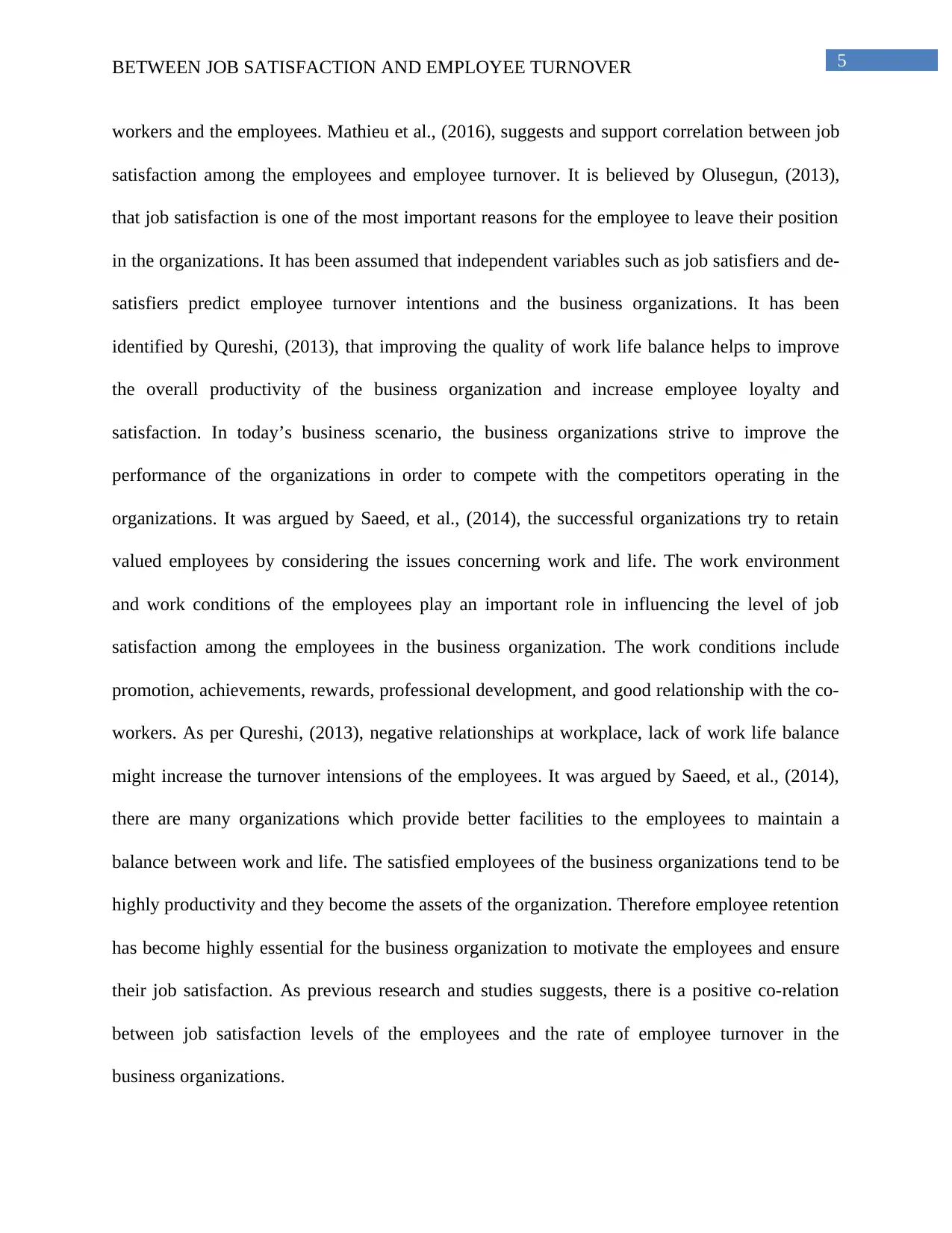
5BETWEEN JOB SATISFACTION AND EMPLOYEE TURNOVER
workers and the employees. Mathieu et al., (2016), suggests and support correlation between job
satisfaction among the employees and employee turnover. It is believed by Olusegun, (2013),
that job satisfaction is one of the most important reasons for the employee to leave their position
in the organizations. It has been assumed that independent variables such as job satisfiers and de-
satisfiers predict employee turnover intentions and the business organizations. It has been
identified by Qureshi, (2013), that improving the quality of work life balance helps to improve
the overall productivity of the business organization and increase employee loyalty and
satisfaction. In today’s business scenario, the business organizations strive to improve the
performance of the organizations in order to compete with the competitors operating in the
organizations. It was argued by Saeed, et al., (2014), the successful organizations try to retain
valued employees by considering the issues concerning work and life. The work environment
and work conditions of the employees play an important role in influencing the level of job
satisfaction among the employees in the business organization. The work conditions include
promotion, achievements, rewards, professional development, and good relationship with the co-
workers. As per Qureshi, (2013), negative relationships at workplace, lack of work life balance
might increase the turnover intensions of the employees. It was argued by Saeed, et al., (2014),
there are many organizations which provide better facilities to the employees to maintain a
balance between work and life. The satisfied employees of the business organizations tend to be
highly productivity and they become the assets of the organization. Therefore employee retention
has become highly essential for the business organization to motivate the employees and ensure
their job satisfaction. As previous research and studies suggests, there is a positive co-relation
between job satisfaction levels of the employees and the rate of employee turnover in the
business organizations.
workers and the employees. Mathieu et al., (2016), suggests and support correlation between job
satisfaction among the employees and employee turnover. It is believed by Olusegun, (2013),
that job satisfaction is one of the most important reasons for the employee to leave their position
in the organizations. It has been assumed that independent variables such as job satisfiers and de-
satisfiers predict employee turnover intentions and the business organizations. It has been
identified by Qureshi, (2013), that improving the quality of work life balance helps to improve
the overall productivity of the business organization and increase employee loyalty and
satisfaction. In today’s business scenario, the business organizations strive to improve the
performance of the organizations in order to compete with the competitors operating in the
organizations. It was argued by Saeed, et al., (2014), the successful organizations try to retain
valued employees by considering the issues concerning work and life. The work environment
and work conditions of the employees play an important role in influencing the level of job
satisfaction among the employees in the business organization. The work conditions include
promotion, achievements, rewards, professional development, and good relationship with the co-
workers. As per Qureshi, (2013), negative relationships at workplace, lack of work life balance
might increase the turnover intensions of the employees. It was argued by Saeed, et al., (2014),
there are many organizations which provide better facilities to the employees to maintain a
balance between work and life. The satisfied employees of the business organizations tend to be
highly productivity and they become the assets of the organization. Therefore employee retention
has become highly essential for the business organization to motivate the employees and ensure
their job satisfaction. As previous research and studies suggests, there is a positive co-relation
between job satisfaction levels of the employees and the rate of employee turnover in the
business organizations.
⊘ This is a preview!⊘
Do you want full access?
Subscribe today to unlock all pages.

Trusted by 1+ million students worldwide
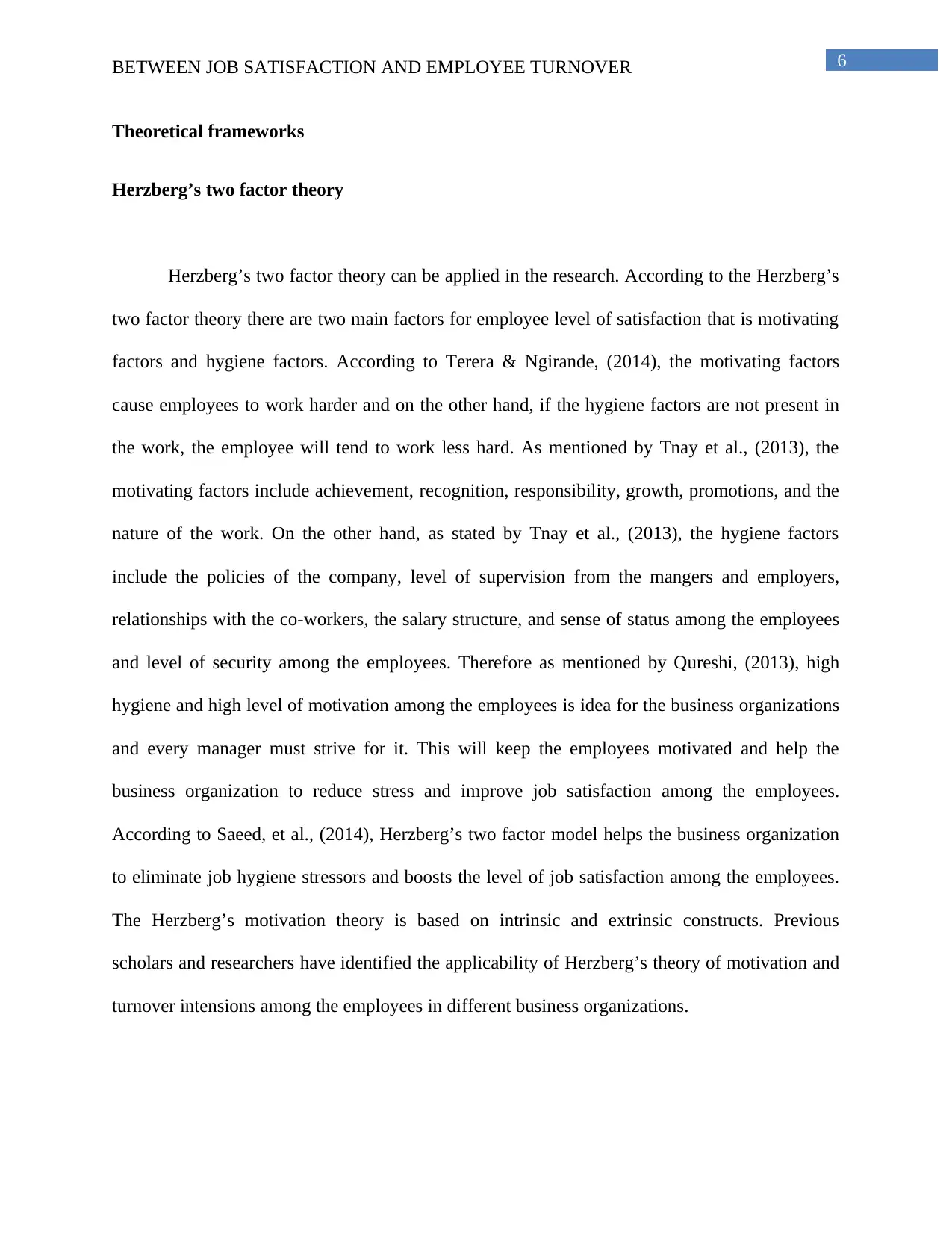
6BETWEEN JOB SATISFACTION AND EMPLOYEE TURNOVER
Theoretical frameworks
Herzberg’s two factor theory
Herzberg’s two factor theory can be applied in the research. According to the Herzberg’s
two factor theory there are two main factors for employee level of satisfaction that is motivating
factors and hygiene factors. According to Terera & Ngirande, (2014), the motivating factors
cause employees to work harder and on the other hand, if the hygiene factors are not present in
the work, the employee will tend to work less hard. As mentioned by Tnay et al., (2013), the
motivating factors include achievement, recognition, responsibility, growth, promotions, and the
nature of the work. On the other hand, as stated by Tnay et al., (2013), the hygiene factors
include the policies of the company, level of supervision from the mangers and employers,
relationships with the co-workers, the salary structure, and sense of status among the employees
and level of security among the employees. Therefore as mentioned by Qureshi, (2013), high
hygiene and high level of motivation among the employees is idea for the business organizations
and every manager must strive for it. This will keep the employees motivated and help the
business organization to reduce stress and improve job satisfaction among the employees.
According to Saeed, et al., (2014), Herzberg’s two factor model helps the business organization
to eliminate job hygiene stressors and boosts the level of job satisfaction among the employees.
The Herzberg’s motivation theory is based on intrinsic and extrinsic constructs. Previous
scholars and researchers have identified the applicability of Herzberg’s theory of motivation and
turnover intensions among the employees in different business organizations.
Theoretical frameworks
Herzberg’s two factor theory
Herzberg’s two factor theory can be applied in the research. According to the Herzberg’s
two factor theory there are two main factors for employee level of satisfaction that is motivating
factors and hygiene factors. According to Terera & Ngirande, (2014), the motivating factors
cause employees to work harder and on the other hand, if the hygiene factors are not present in
the work, the employee will tend to work less hard. As mentioned by Tnay et al., (2013), the
motivating factors include achievement, recognition, responsibility, growth, promotions, and the
nature of the work. On the other hand, as stated by Tnay et al., (2013), the hygiene factors
include the policies of the company, level of supervision from the mangers and employers,
relationships with the co-workers, the salary structure, and sense of status among the employees
and level of security among the employees. Therefore as mentioned by Qureshi, (2013), high
hygiene and high level of motivation among the employees is idea for the business organizations
and every manager must strive for it. This will keep the employees motivated and help the
business organization to reduce stress and improve job satisfaction among the employees.
According to Saeed, et al., (2014), Herzberg’s two factor model helps the business organization
to eliminate job hygiene stressors and boosts the level of job satisfaction among the employees.
The Herzberg’s motivation theory is based on intrinsic and extrinsic constructs. Previous
scholars and researchers have identified the applicability of Herzberg’s theory of motivation and
turnover intensions among the employees in different business organizations.
Paraphrase This Document
Need a fresh take? Get an instant paraphrase of this document with our AI Paraphraser
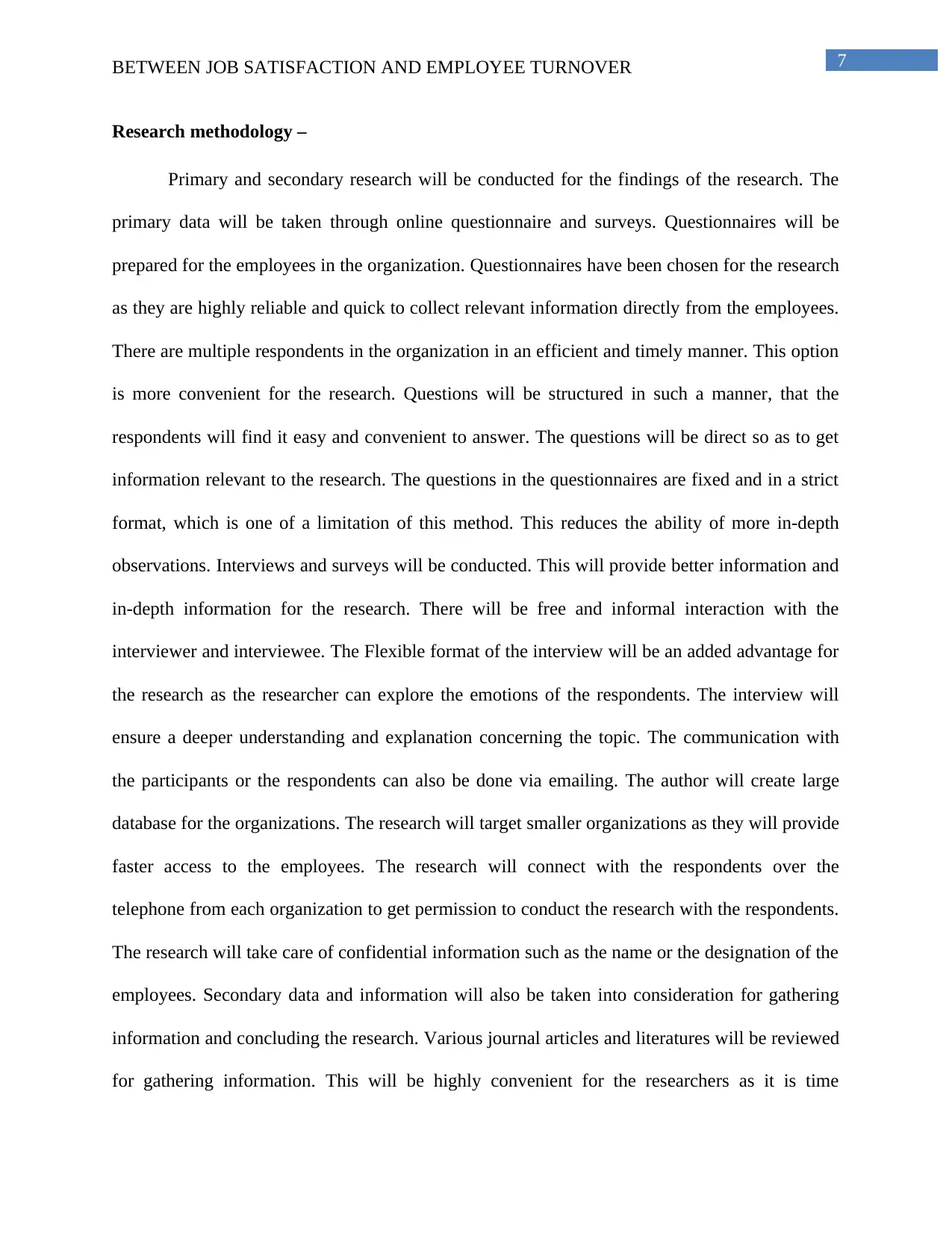
7BETWEEN JOB SATISFACTION AND EMPLOYEE TURNOVER
Research methodology –
Primary and secondary research will be conducted for the findings of the research. The
primary data will be taken through online questionnaire and surveys. Questionnaires will be
prepared for the employees in the organization. Questionnaires have been chosen for the research
as they are highly reliable and quick to collect relevant information directly from the employees.
There are multiple respondents in the organization in an efficient and timely manner. This option
is more convenient for the research. Questions will be structured in such a manner, that the
respondents will find it easy and convenient to answer. The questions will be direct so as to get
information relevant to the research. The questions in the questionnaires are fixed and in a strict
format, which is one of a limitation of this method. This reduces the ability of more in-depth
observations. Interviews and surveys will be conducted. This will provide better information and
in-depth information for the research. There will be free and informal interaction with the
interviewer and interviewee. The Flexible format of the interview will be an added advantage for
the research as the researcher can explore the emotions of the respondents. The interview will
ensure a deeper understanding and explanation concerning the topic. The communication with
the participants or the respondents can also be done via emailing. The author will create large
database for the organizations. The research will target smaller organizations as they will provide
faster access to the employees. The research will connect with the respondents over the
telephone from each organization to get permission to conduct the research with the respondents.
The research will take care of confidential information such as the name or the designation of the
employees. Secondary data and information will also be taken into consideration for gathering
information and concluding the research. Various journal articles and literatures will be reviewed
for gathering information. This will be highly convenient for the researchers as it is time
Research methodology –
Primary and secondary research will be conducted for the findings of the research. The
primary data will be taken through online questionnaire and surveys. Questionnaires will be
prepared for the employees in the organization. Questionnaires have been chosen for the research
as they are highly reliable and quick to collect relevant information directly from the employees.
There are multiple respondents in the organization in an efficient and timely manner. This option
is more convenient for the research. Questions will be structured in such a manner, that the
respondents will find it easy and convenient to answer. The questions will be direct so as to get
information relevant to the research. The questions in the questionnaires are fixed and in a strict
format, which is one of a limitation of this method. This reduces the ability of more in-depth
observations. Interviews and surveys will be conducted. This will provide better information and
in-depth information for the research. There will be free and informal interaction with the
interviewer and interviewee. The Flexible format of the interview will be an added advantage for
the research as the researcher can explore the emotions of the respondents. The interview will
ensure a deeper understanding and explanation concerning the topic. The communication with
the participants or the respondents can also be done via emailing. The author will create large
database for the organizations. The research will target smaller organizations as they will provide
faster access to the employees. The research will connect with the respondents over the
telephone from each organization to get permission to conduct the research with the respondents.
The research will take care of confidential information such as the name or the designation of the
employees. Secondary data and information will also be taken into consideration for gathering
information and concluding the research. Various journal articles and literatures will be reviewed
for gathering information. This will be highly convenient for the researchers as it is time
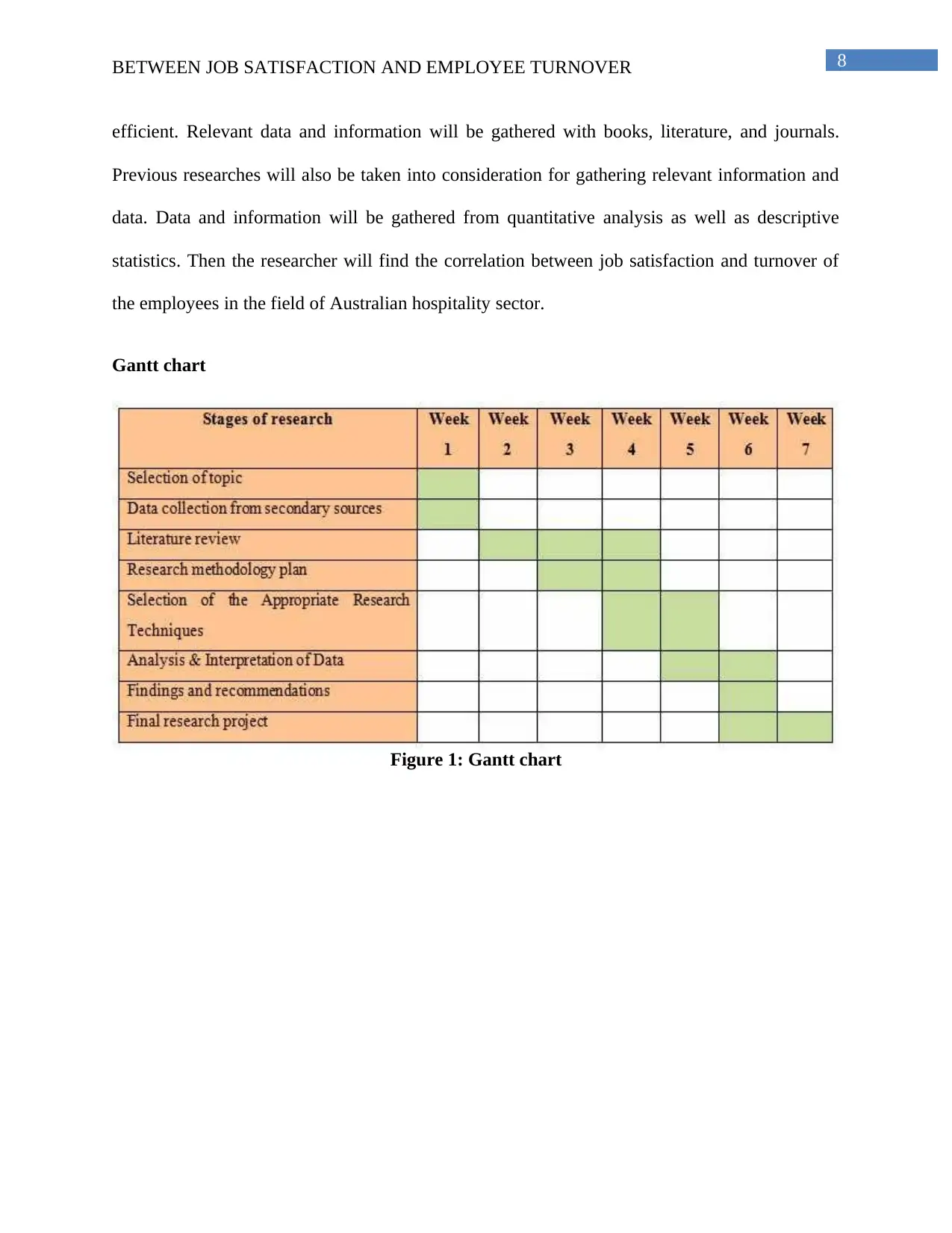
8BETWEEN JOB SATISFACTION AND EMPLOYEE TURNOVER
efficient. Relevant data and information will be gathered with books, literature, and journals.
Previous researches will also be taken into consideration for gathering relevant information and
data. Data and information will be gathered from quantitative analysis as well as descriptive
statistics. Then the researcher will find the correlation between job satisfaction and turnover of
the employees in the field of Australian hospitality sector.
Gantt chart
Figure 1: Gantt chart
efficient. Relevant data and information will be gathered with books, literature, and journals.
Previous researches will also be taken into consideration for gathering relevant information and
data. Data and information will be gathered from quantitative analysis as well as descriptive
statistics. Then the researcher will find the correlation between job satisfaction and turnover of
the employees in the field of Australian hospitality sector.
Gantt chart
Figure 1: Gantt chart
⊘ This is a preview!⊘
Do you want full access?
Subscribe today to unlock all pages.

Trusted by 1+ million students worldwide
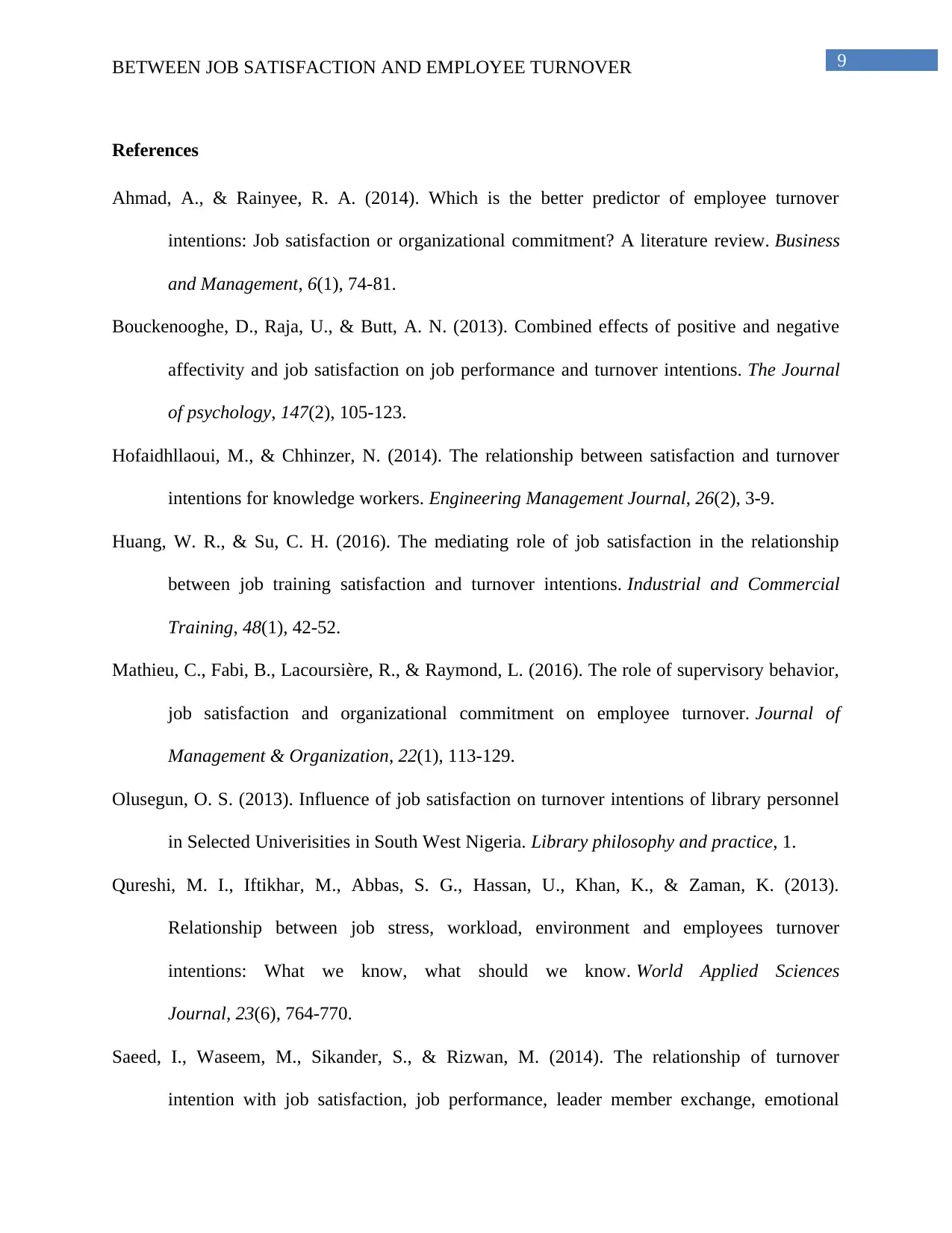
9BETWEEN JOB SATISFACTION AND EMPLOYEE TURNOVER
References
Ahmad, A., & Rainyee, R. A. (2014). Which is the better predictor of employee turnover
intentions: Job satisfaction or organizational commitment? A literature review. Business
and Management, 6(1), 74-81.
Bouckenooghe, D., Raja, U., & Butt, A. N. (2013). Combined effects of positive and negative
affectivity and job satisfaction on job performance and turnover intentions. The Journal
of psychology, 147(2), 105-123.
Hofaidhllaoui, M., & Chhinzer, N. (2014). The relationship between satisfaction and turnover
intentions for knowledge workers. Engineering Management Journal, 26(2), 3-9.
Huang, W. R., & Su, C. H. (2016). The mediating role of job satisfaction in the relationship
between job training satisfaction and turnover intentions. Industrial and Commercial
Training, 48(1), 42-52.
Mathieu, C., Fabi, B., Lacoursière, R., & Raymond, L. (2016). The role of supervisory behavior,
job satisfaction and organizational commitment on employee turnover. Journal of
Management & Organization, 22(1), 113-129.
Olusegun, O. S. (2013). Influence of job satisfaction on turnover intentions of library personnel
in Selected Univerisities in South West Nigeria. Library philosophy and practice, 1.
Qureshi, M. I., Iftikhar, M., Abbas, S. G., Hassan, U., Khan, K., & Zaman, K. (2013).
Relationship between job stress, workload, environment and employees turnover
intentions: What we know, what should we know. World Applied Sciences
Journal, 23(6), 764-770.
Saeed, I., Waseem, M., Sikander, S., & Rizwan, M. (2014). The relationship of turnover
intention with job satisfaction, job performance, leader member exchange, emotional
References
Ahmad, A., & Rainyee, R. A. (2014). Which is the better predictor of employee turnover
intentions: Job satisfaction or organizational commitment? A literature review. Business
and Management, 6(1), 74-81.
Bouckenooghe, D., Raja, U., & Butt, A. N. (2013). Combined effects of positive and negative
affectivity and job satisfaction on job performance and turnover intentions. The Journal
of psychology, 147(2), 105-123.
Hofaidhllaoui, M., & Chhinzer, N. (2014). The relationship between satisfaction and turnover
intentions for knowledge workers. Engineering Management Journal, 26(2), 3-9.
Huang, W. R., & Su, C. H. (2016). The mediating role of job satisfaction in the relationship
between job training satisfaction and turnover intentions. Industrial and Commercial
Training, 48(1), 42-52.
Mathieu, C., Fabi, B., Lacoursière, R., & Raymond, L. (2016). The role of supervisory behavior,
job satisfaction and organizational commitment on employee turnover. Journal of
Management & Organization, 22(1), 113-129.
Olusegun, O. S. (2013). Influence of job satisfaction on turnover intentions of library personnel
in Selected Univerisities in South West Nigeria. Library philosophy and practice, 1.
Qureshi, M. I., Iftikhar, M., Abbas, S. G., Hassan, U., Khan, K., & Zaman, K. (2013).
Relationship between job stress, workload, environment and employees turnover
intentions: What we know, what should we know. World Applied Sciences
Journal, 23(6), 764-770.
Saeed, I., Waseem, M., Sikander, S., & Rizwan, M. (2014). The relationship of turnover
intention with job satisfaction, job performance, leader member exchange, emotional
Paraphrase This Document
Need a fresh take? Get an instant paraphrase of this document with our AI Paraphraser
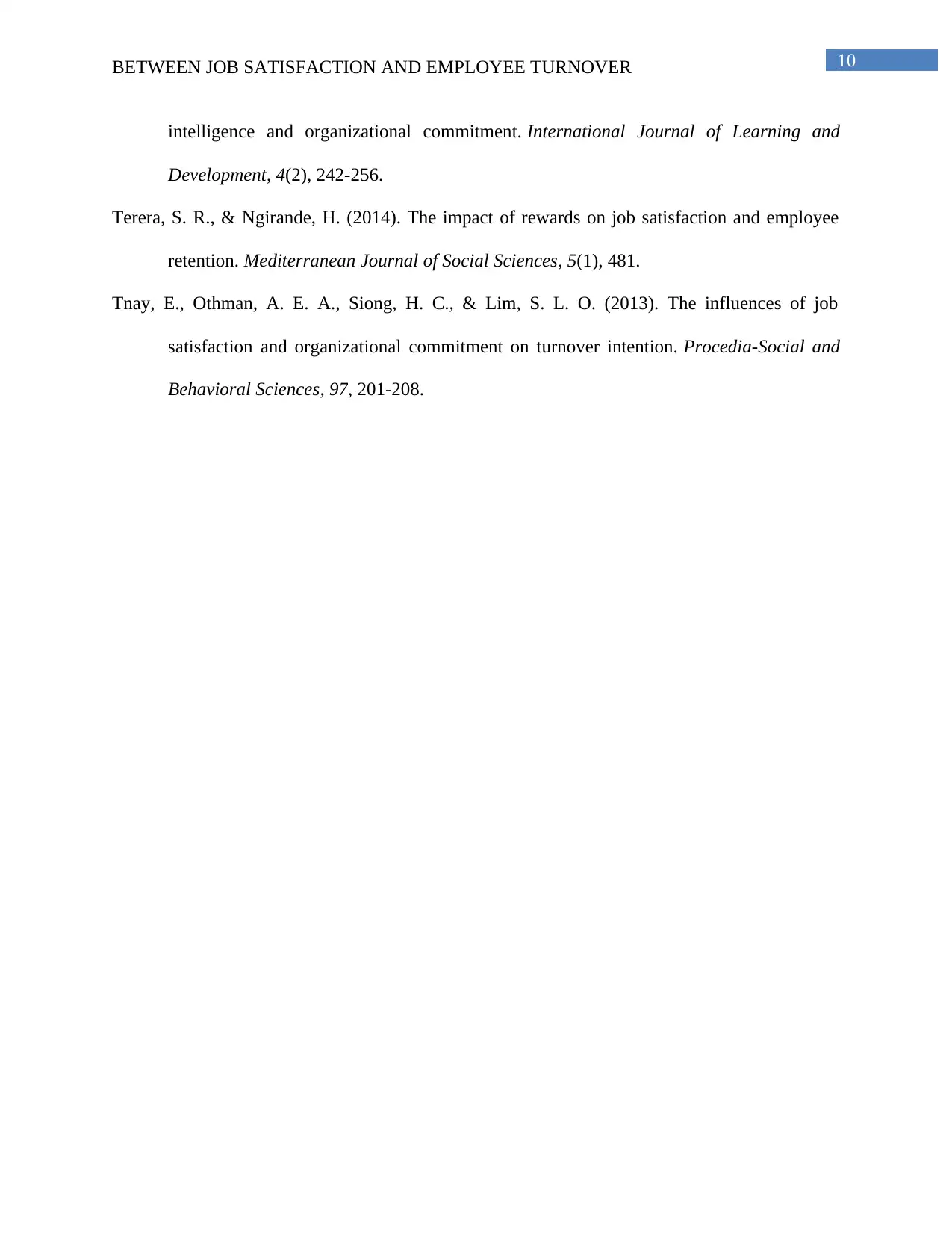
10BETWEEN JOB SATISFACTION AND EMPLOYEE TURNOVER
intelligence and organizational commitment. International Journal of Learning and
Development, 4(2), 242-256.
Terera, S. R., & Ngirande, H. (2014). The impact of rewards on job satisfaction and employee
retention. Mediterranean Journal of Social Sciences, 5(1), 481.
Tnay, E., Othman, A. E. A., Siong, H. C., & Lim, S. L. O. (2013). The influences of job
satisfaction and organizational commitment on turnover intention. Procedia-Social and
Behavioral Sciences, 97, 201-208.
intelligence and organizational commitment. International Journal of Learning and
Development, 4(2), 242-256.
Terera, S. R., & Ngirande, H. (2014). The impact of rewards on job satisfaction and employee
retention. Mediterranean Journal of Social Sciences, 5(1), 481.
Tnay, E., Othman, A. E. A., Siong, H. C., & Lim, S. L. O. (2013). The influences of job
satisfaction and organizational commitment on turnover intention. Procedia-Social and
Behavioral Sciences, 97, 201-208.
1 out of 11
Related Documents
Your All-in-One AI-Powered Toolkit for Academic Success.
+13062052269
info@desklib.com
Available 24*7 on WhatsApp / Email
![[object Object]](/_next/static/media/star-bottom.7253800d.svg)
Unlock your academic potential
Copyright © 2020–2025 A2Z Services. All Rights Reserved. Developed and managed by ZUCOL.





